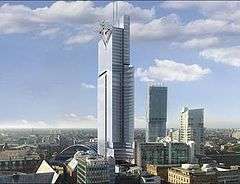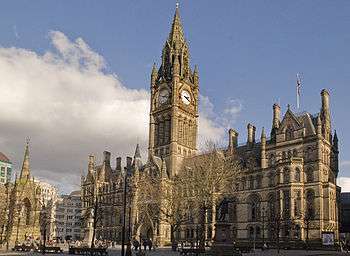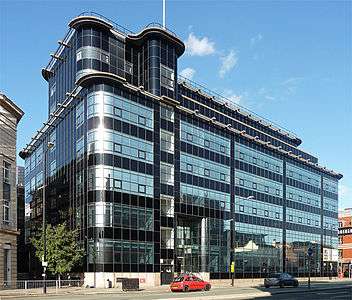Intercontinental Tower, Manchester
| Intercontinental Tower | |
|---|---|
|
Artist's render of how the preferred design was to look when constructed | |
| General information | |
| Status | Never built |
| Type | Hotel / Residential |
| Location | Windmill Street, Manchester |
| Cost | £80m[1] |
| Management | InterContinental Hotels Group |
| Height | |
| Antenna spire | 200 m (660 ft) max |
| Roof | 160 m (520 ft) est. |
| Technical details | |
| Floor count | 30 to 48 stories est. |
| Design and construction | |
| Architect | Stephenson Bell |
| Developer | Benmore |
| Other information | |
| Number of rooms | 250 |

The Intercontinental Tower, Manchester is a cancelled landmark skyscraper for construction in Manchester City Centre, England. The proposed high rise would have been a 5-star luxury hotel run by InterContinental Hotels Group, and developed by Northern Irish development firm, Benmore.
The skyscraper was proposed in a press release by developer Benmore in May 2009 and discussed with Manchester City Council in summer 2009. In 2010, the tower was part of the city council's preliminary plans to regenerate the surrounding civic quarter, and opposition to building a skyscraper in the heart of its historic district has been minimal.
The tower would feature a helipad and two decorative spires, much like the Willis Tower in Chicago, which would take its pinnacle height to approximately 200m, 30m taller than Manchester's tallest skyscraper, the Beetham Tower. The plans for the 48-storey tower were drawn up before the recession but were abandoned when the financial market crashed. Planning negotiations have resumed and architect Roger Stephenson has designed a 25-storey tower to contain 270 hotel rooms and presidential suite at the top. The theatre façade will be retained to become the entrance to the hotel foyer. The structure will be created behind the theatre's façade
Background
The skyscraper was proposed in May 2008 as the Theatre Royal Tower[2] and the initial design was modified to its current state. Its height was increased from approximately 118m to 200m.
Developers, Benmore, who have invested in Manchester revealed in a press release that it was in advanced negotiations to bring an internationally renowned hotel chain to the City - the first of that brand in the North West.[3] InterContinental Hotels Group were linked to the development.[4] A factor in the proposal is it would be within the security cordon for Manchester Central Conference Centre which is a popular destination for business and political conferences.[5]
The tower would be close enough to the Beetham Tower to form a coherent cluster. Also planned is a helipad on top of the skyscraper which would be the first of its kind in the United Kingdom.[6]
In October 2009, the general manager of Manchester's Radisson Edwardian Hotel believed the city had reached a 'tipping point' and would not see any major hotel investment for three years.[7] Manchester City Council held a public consultation on the plans in February 2010. The Radisson Edwardian had "no objection to the re-instatement of the theatre here [Library Theatre] but object strongly to the proposal to redevelop the site for a ‘tall’ building which they define as any building exceeding 15 storeys."[8] The council acknowledged that "a new quality hotel" was being planned but claimed the "The principle of a taller building on this site was established when planning permission was granted for a 17 storey office building on 2 June 2005. The impact on the historic environment (and in every other sense) of a scheme of this height was considered to be acceptable at that time. Therefore, officers do not consider that development at the Theatre Royal site should not exceed 15 storeys." Under the proposal the skyscraper would be built to the rear of the Manchester Theatre Royal which would restored and its future preserved.[9]
See also
References
- ↑ "Benmore signs InterContinental Hotels at Theatre Royal". placenorthwest.co.uk. 17 September 2009. Retrieved 28 September 2010.
- ↑ skyscrapernews.com Theatre Royal Tower
- ↑ Benmore Group Benmore Continues to Invest in Manchester - Press Release
- ↑ - www.urbanrealm.co.uk - Intercontinental Hotels Group eye Manchester
- ↑ Ottewell, David (12 August 2009). "Labour party conference will return to Manchester". Manchester Evening News. M.E.N. Media.
- ↑ - skyscrapernews.com - Intercontinental And Benmore Set For Skyscraper
- ↑ thebusinessdesk.com Hotel market to catch its breath after growth spurt
- ↑ "Manchester City Council Report for Resolution" (PDF). Manchester City Council Executive. 10 February 2010. p. 5. Retrieved 3 October 2010.
- ↑ Burdett, Jill (17 September 2009). "30-storey tower plan for Theatre Royal". Manchester Evening News. M.E.N. Media.
External links
Coordinates: 53°28′39″N 2°14′48″W / 53.4774°N 2.2466°W






